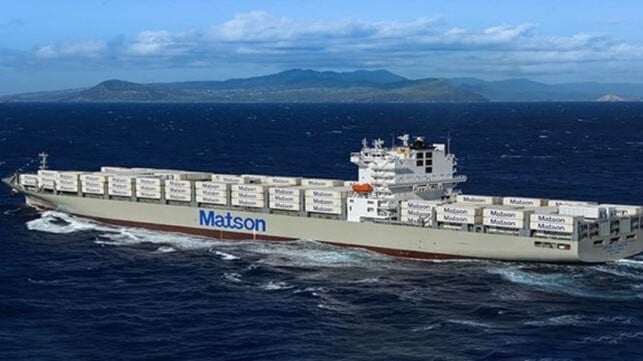Kongsberg Maritime Selects Corvus Energy Battery Systems for Matson’s Ships

[By: Corvus Energy]
Matson Navigation Company’s three new 3600 TEU Aloha Class containerships, the largest container ships built in the United States, will use Kongsberg Maritime Hybrid Electrical Systems that incorporate Corvus Energy Orca ESS.
Corvus Energy, a leader in marine energy storage solutions, has been selected by Kongsberg Maritime to supply marine Energy Storage Systems (ESS) for Maston Navigation Company’s new LNG-powered Aloha Class containerships designed by KOMAC.
Advancing sustainable shipping
With a carrying capacity of 3,600 TEU,* the 260-metre (854-foot) Matson Aloha Class vessels are the largest container ships built in the United States. Matson is expanding its fleet of two Aloha Class vessels with the addition of three, new Jones Act-compliant container ships.
The vessels will feature a next-generation, LNG-ready design that is optimized for energy efficiency and emissions reduction. Equipped with “green ship technology” and dual fuel engines, the ships will be able to operate using either conventional marine fuels or liquefied natural gas (LNG).
Due to the vessels’ large-scale size and energy-saving capacity, Matson’s expansion of their Aloha Class fleet represents an important advancement towards more sustainable shipping.
Designed to optimise energy efficiency and emissions reduction
The new LNG-powered container ships play a key role in Matson’s emissions reduction strategy. The Company set corporate goals to achieve a 40 percent reduction in Scope 1 greenhouse gas (GHG) fleet emissions by 2030 and net-zero Scope 1 GHG emissions by 2050. (Source)
Fundamental to the vessels’ energy-efficient design, Kongsberg Maritime will supply a range of integrated technologies designed to optimise energy use and reduce emissions. Notably, each of the three new container ships will be equipped with a Kongsberg Maritime Hybrid Electrical System packaged solution that includes a Corvus Energy ESS.
According to Kongsberg Maritime, “Matson Navigation Company, through their investment in three new LNG-powered container ships, is making a clear commitment to decarbonise its operations. We are delighted to be supporting their environmental goals through the supply of a range of green ship technologies, like our hybrid shaft generator system. That, together with the batteries supplied by Corvus Energy, will optimise energy usage and reduce emissions,” said Lasse Brynsrud, Senior Sales Manager Marine Transportation in Kongsberg Maritime.
Corvus Energy involvement
Each vessel will be outfitted with a 1492 kWh Corvus Orca system. The Corvus Orca ESS is the most installed marine battery system worldwide, used onboard more than 700 maritime vessels around the world.
According to Tor-Gunnar Hovig, SVP Sales Americas for Corvus Energy, “Corvus is pleased to have been selected by Kongsberg Maritime to supply energy storage for the Matson Navigation Company Aloha Class Containerships, which will help to reduce emissions generated by the largest container ships built in the United States.”
Within the shipping sector, Corvus Energy ESS power hybrid merchant, cargo, bulk carrier, tanker and containership vessels operating around the world. Hovig explains, “while vessel electrification is more common for near shore applications, such as ferries and tugs, the use of battery systems within the shipping sector is also increasing, particularly due to advances in ESS technology and escalating focus on emissions reduction. This project with Matson is one example of trends we’re seeing towards hybridization in the shipping sector.”
Construction Timeline and Vessel Operation Route
Construction is underway at Philly Shipyard for the first of the three new container ships, with vessels scheduled for delivery to Matson in 2026 and 2027.
The new ships are being built to provide additional capacity and speed benefitting Matson’s Hawaii and China-Long Beach Express (CLX) service routes.
The products and services herein described in this press release are not endorsed by The Maritime Executive.
